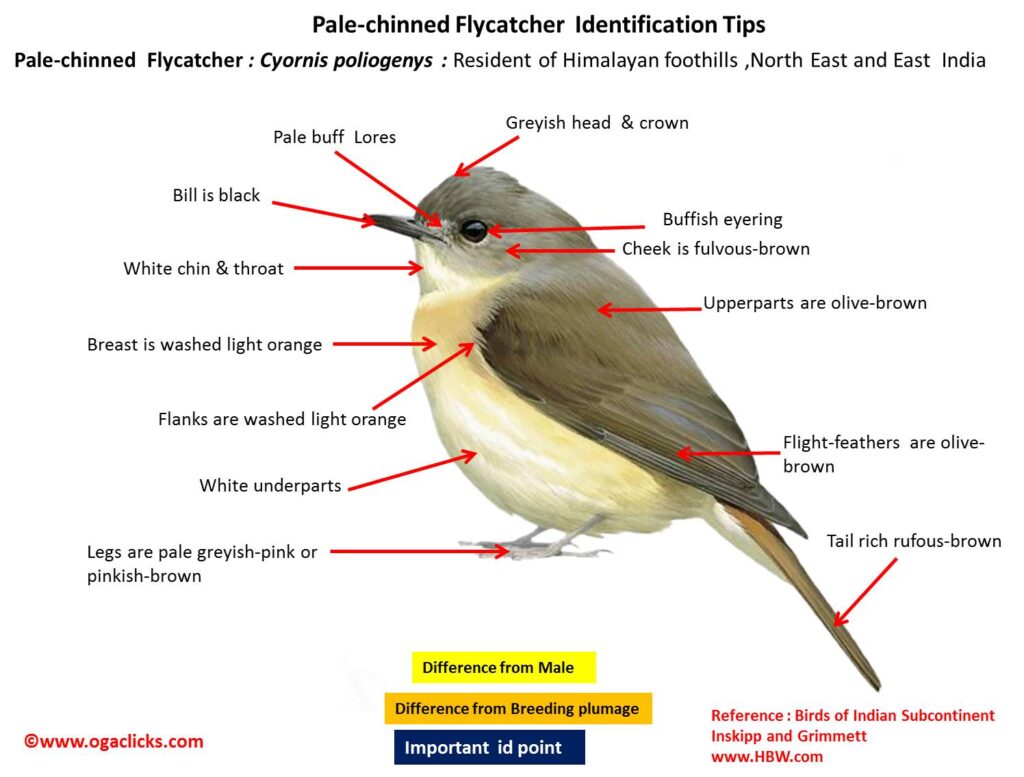
Pale-chinned Flycatcher Cyornis poliogenys
Etymology:
-
- Cyornis : Greek Word kuanos dark-blue; ornis
-
- Poliogenys : Greek word polios-grey ; genus cheek
-
-
- Cacharensis / Cachariensis : Cachar District, Assam, India
-
-
-
- Vernayi / Verneyi : Arthur Stannard Vernay (1877-1960) English/US antiquarian, collector.
-
Sub Species :
- Nominate – Central Himalayas to North East India (West & South Assam, Meghalaya)
- p. cachariensis – North East India (Arunachal Pradesh, East & South East Assam, Nagaland, Manipur, Mizoram) {head and back dull olive-brown, lacks grey tinge on head, has deeper chestnut on uppertail-coverts and edges of tail, darker orange-rufous on breast extending to throat}
- p. vernayi – Eastern Ghats, in East India {male has variable amount of bluish-grey above, more bluish in S (N Andhra Pradesh) and browner in N (Orissa), most with bluish-grey on head and edges of flight-feathers and outer tail feathers, others with blue restricted to head only}.
Distribution in India:
- Nominate – Central Himalayas to North East India (West & South Assam, Meghalaya)
- p. cachariensis – North East India (Arunachal Pradesh, East & South East Assam, Nagaland, Manipur, Mizoram
- p. vernayi – Eastern Ghats, in East India.
Description: Size of 15·5–18 cm. It is a medium-sized to large, fairly nondescript olive-brown flycatcher. The nominate race has greyish crown and face .It has broad pale buff on lores to eyering separated from buff of chin and throat by narrow dark malar stripe. The nape and upperparts, including upperwing-coverts are olive-brown. The edges of flight-feathers are slightly warmer or light rufous-brown; uppertail-coverts and tail are rich rufous-brown. The breast and flanks washed light orange, lower flanks are buffish-brown, belly is whitish, becoming creamy on undertail-coverts. The iris is dark brown; bill is black; legs are pale greyish-pink or pinkish-brown. Both the sexes are alike. The juvenile has head and upperparts as dark olive-brown, heavily speckled with pale buff and broadly barred darker, wing and tail as adult or slightly duller, wing-coverts with small pale buffish tips forming indistinct wingbars, chin and throat light buff, breast heavily barred dark brown and buff, fading on flanks, belly is whitish. Races cachariensis has head and back dull olive-brown, lacks grey tinge on head, has deeper chestnut on uppertail-coverts and edges of tail, darker orange-rufous on breast extending to throat. Race vernayi male has variable amount of bluish-grey above, more bluish in S (N Andhra Pradesh) and browner in N (Orissa), most with bluish-grey on head and edges of flight-feathers and outer tail feathers, others with blue restricted to head only.
Habitat: It is found in open broadleaf deciduous and evergreen forests. It is found in breeding season from 270 mm–1500. In non-breeding season it occurs more widely in open country with scrub.
Food habits: It eats small to medium-sized invertebrates. It is found usually solitary or in pairs. It forages at all levels, from undergrowth and low bushes to canopy of forest trees, occasionally near or on ground.
Breeding habits: They breed in Apr to Jun. The nest is built by both sexes. The nest is bracket-shaped or cup-shaped structure of moss, leaves, dry grass and fine rootlets, placed in depression in bank or among boulders or in tree stump.. They lay a clutch of 3-5 eggs. The incubation of eggs done by both sexes.